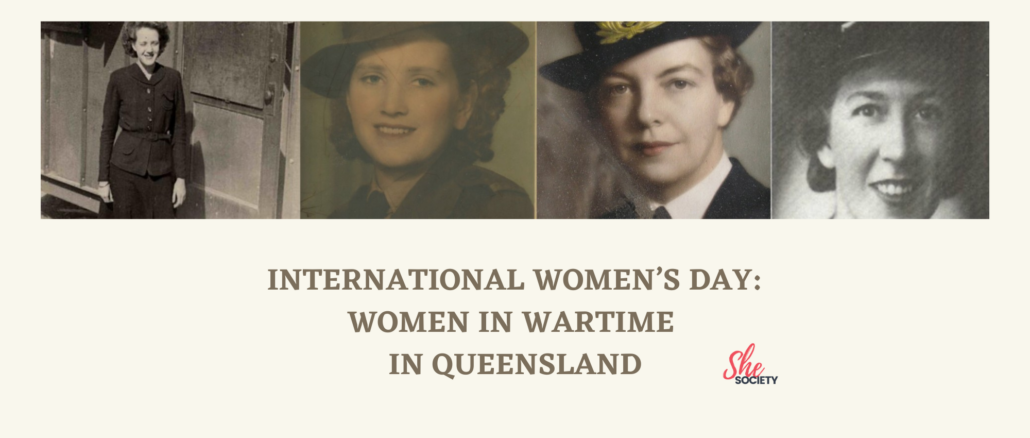
International Women’s Day (IWD) is upon us and in celebration of our achievements I most humbly attended a presentation Women In Wartime, held at Brisbane’s ANZAC Square & Memorial Galleries (285 Ann St, Brisbane, beneath the Shrine of Remembrance).
The presentation was given by special guest speaker Suzanne Mulligan. Oral Historian, and Life Member of the Oral History Association of Australia, who has been recording the stories of interesting people for 20 years. In the State Library of Queensland they hold a collection of her oral histories of 32 Queenslanders. Their backgrounds were diverse; war veterans, photographers, a Paralympian, a round-the-world yachtsman.
Suzanne has also collected a wealth of information exploring the role and experiences of Women In Wartime. She had met many of these quiet, humble remarkable Australian women who contributed to the war effort on the home front during World War II.
Her talk was captivating; we could have listened to her for hours. Given the time frames, out of the thousands of women eager to do their bit in WWII, Suzanne chose to highlight five women for her presentation to coincide with IWD.
- Eve Scott – a member of the Women’s Auxiliary Australian Air Force (WAAAF) who worked with the codebreakers in Brisbane
- Edith Edwards – a member of the Australian Women’s Land Army who worked on country farms
- Doreen Balfour – a nurse who worked in an Australian hospital
- Hazel Hernsdorf – a secretary who worked for the US Navy in Brisbane
- Muriel Bath – a member of the Women’s Royal Australian Naval Service (WRANS) who worked as a cipher officer
Extracts from interviews:
Eve
Trained as a shorthand typist Eve did the coding, the yanks did the decoding. They were banned from talking about their work.
Edith
Was born in Brisbane and worked on the farms as part of the war effort to supply food. She laughed about the time she was sent to a pineapple farm. I never knew pineapples grew above the ground until I got there. In 1995 the Land Army was able to participate in the ANZAC Day march for the first time.
Hazel
Was sent to a navy hospital in Brisbane, we were fearful of being bombed by the Japanese. But the Americans were wonderful she said. There were several murders at the time. One soldier killed his commanding office due to psychological issues but he had such a lovely face she said you wouldn’t believe he was a murderer. He was hung on one of the islands as hanging was not allowed in Queensland. Girls were advised not to marry the Americans as they were only in Australia for six months.
Muriel
She was almost 100 when Suzanne interviewed her. Was born in England and immigrated to Australia working as a stenographer. Joined the Women’s Royal Australian Navel Serviced (WRANS). She did not end up filling inkwells as thought by her former male boss. Muriel was handling top secret material. I am a cipher office. She was the first woman to join the Queensland Police Force in 1947.
Doreen
Related a wonderful tale about injured soldiers being admitted to hospital. The nurses were required to register the soldiers’ fire arms and lock them away before being allowed to enter the wards. The risk of the soldiers being trigger happy from war trauma too great.
***
I think I speak for most of the audience. It was a delight to hear the voices of these quiet achievers relating their tales in their own words. When Suzanne said they were told they were banned from talking about their work, my heart ached for them. I can’t imagine the burden and unspoken anguish these women held within them.
Their stories unique, their sense of humour a reflection of their survival not only from the war but the endless heartbreaking discriminative barriers women battled just because they were a woman. Their voices on air, anecdotes, and sense of humour made them all so human. Fortunately, they received recognition when Julia Gillard, the then Prime Minister of Australia (between 2010 & 2013) invited the unsung women at wartime to Canberra
Following the talk, we browsed through the many memorial plaques that line the walls of the museum. There are fabulous large flat touch screens in the centre of the main room to access further information. Well worth a visit if you haven’t already.
My full admiration and gratefulness to Suzanne Mulligan. She has given a voice to those who didn’t make it into the history books. They undeniably did more than their bit. You can hear Suzanne’s interviews on her website. The public has online access to clippings, photographs, oral histories and transcripts.
For more detailed information and full interviews by Suzanne, click on the links below. Listen to these wonderful Women In Wartime as well as other tales from a former hairdresser and ten-pound POM, the oldest old boy of the Toowong Rowing Club, former prison warden at Boggo Road and Wacol Prison and so many more.
Acknowledgement & Information:
Suzanne Mulligan Email : mulligan53@iinet.net.au , (07) 3375 1865
https://mulliganoralhistory.info
www.anzacsquare@slq.qld.gov.au
SheSociety is a site for the women of Australia to share our stories, our experiences, shared learnings and opportunities to connect.


Leave a Reply